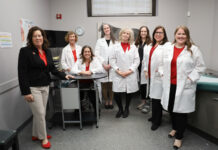Open-angle glaucoma, also known as primary or chronic glaucoma, accounts for about 90 percent of all glaucoma cases in the United States, affecting about 3 million Americans. It is caused by the slow clogging of the drainage canals, resulting in increased eye pressure. It develops slowly and is a lifelong condition.
Angle-closure glaucoma, a less common form of glaucoma also known as acute or narrow-angle glaucoma, is caused by blocked drainage canals, resulting in a sudden rise in eye pressure. It develops very quickly and demands immediate medical attention.
Everyone is at risk for glaucoma, Soltau said. However, certain groups are at higher risk than others. After cataracts, glaucoma is the leading cause of blindness among African Americans and people of African descent. Glaucoma is six to eight times more common in African Americans than in European Americans. Glaucoma is also more common among older people. You are six times more likely to get glaucoma if you are more than 60 years old.
The most common type of glaucoma, primary open-angle glaucoma, is hereditary. If members of your immediate family have glaucoma, you are at a much higher risk than the rest of the population. Family history increases risk of glaucoma four to nine times. Other risk factors include nearsightedness and hypertension.
If you are at higher risk for glaucoma, you should have a thorough eye exam every one or two years after age 35, according to Soltau. If you’re diagnosed with glaucoma, it is important to work with your eye doctor and carefully follow your prescribed treatment, which can include medications or surgery.
Contact UofL Physicians-Eye Specialists at 502-852-5466.
Editor’s Note: UofL Today reprints To Your Health articles from the “UofL Physicians-Insider” newsletter. Read the entire January Issue (opens as a PDF document).




























